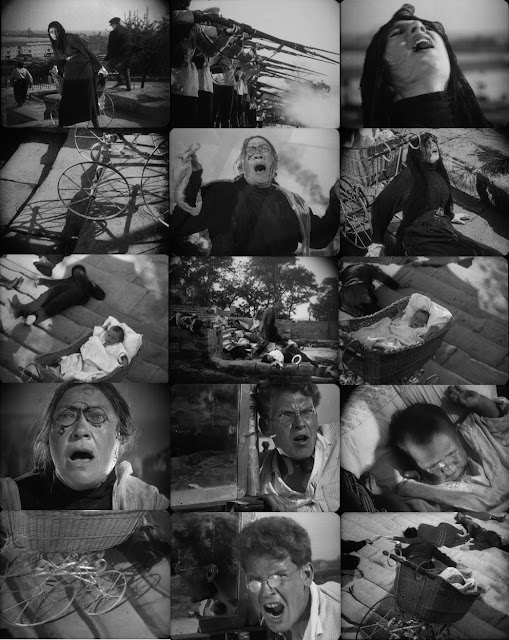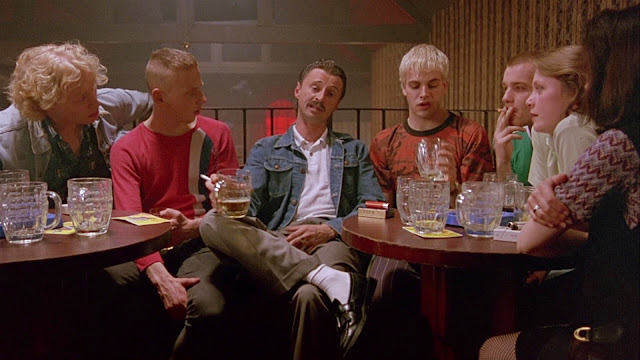Specialist Study Area: The Realist and the Expressive
Critical debates surrounding the realist and the expressive is a Specialist Study Area for Section C: Film Movements - Silent Cinema on the second exam paper Component 2: Global Filmmaking Perspectives, where you may be asked to discuss realism versus expressionism in relation to the silent American comedy short films by Buster Keaton (One Week, The Scarecrow, The 'High Sign' and Cops).
Some time after the release of Keaton's short films (in the 1940s) French film critic Andre Bazin sparked a major debate within film when he suggested that two styles of filmmaking that had developed in the 1910s and 1920s (German Expressionism and Soviet Montage) went against what he saw as the 'realist' style that he believed should be at the heart of cinema. Though it was Bazin who crystallized this debate, this opposition between the realist and the expressive had, in fact, informed critical thinking and discussion about film from the very beginnings of cinema when the documentary realism of films made by early film pioneers the Lumiere Brothers was set in opposition to the fantasy films of George Melies.
The first moving films were screened in Paris in 1895 when the Lumiere Brothers projected their 'actualities'; short one or two minute films which depicted real events. Relatively quickly, slightly longer (two to three minute) narrative films emerged, including those directed by stage magician-turned-filmmaker George Melies. Melies employed both physical magic and early in-camera special effects to create the fantastical worlds in his films. Looking at the clips above, it should be clear to see the distinctive styles of realist and expressive filmmaking.
By the early 1900s films had become considerably longer and as film language continued to develop so, too, did more complex narratives and characters. American film director DW Griffith, often referred to as 'the father of film' was a key figure in this transition from early 'primitive' cinema and directed over 450 one-reel (roughly ten minutes long) and two reel-films between 1908 and 1913. These films experimented with the ways in which cinematography, mise-en-scene, editing and performance could be used to tell a story and his films laid the template for what became known as classical Hollywood cinema. These types of films sought to present a sense of verisimilitude (an appearance of truth or reality) through their narratives and characters.
Alongside this classical narrative cinema other film movements emerged, such as German Expressionism and Soviet Montage, which utilised film form in striking ways that were anti-realist.
When discussing Buster Keaton's short films you may be asked whether you feel his work is realist or expressive. It is certainly possible to argue that Keaton's work is expressive, particularly if you focus on the surreal gags that run throughout his films and when you consider his elaborate sets and the ways in which many of the props are used in his films. The very nature of slapstick silent film comedy and the premises of Keaton's narratives frequently lead students to consider his film as expressive rather than realist.
There are, however, many elements of Keaton's films which are in the realist tradition of filmmaking, such as the choice of realist camera distances (long shots and extreme long shots), aspects of framing and composition (deep focus cinematography), the pace of the editing (long takes), elements of mise-en-scene such as outdoor locations and natural lighting (cinematography). It is perhaps best, then to suggest that Keaton's work contains elements of both the expressive and realist traditions of filmmaking.
The first moving films were screened in Paris in 1895 when the Lumiere Brothers projected their 'actualities'; short one or two minute films which depicted real events. Relatively quickly, slightly longer (two to three minute) narrative films emerged, including those directed by stage magician-turned-filmmaker George Melies. Melies employed both physical magic and early in-camera special effects to create the fantastical worlds in his films. Looking at the clips above, it should be clear to see the distinctive styles of realist and expressive filmmaking.
By the early 1900s films had become considerably longer and as film language continued to develop so, too, did more complex narratives and characters. American film director DW Griffith, often referred to as 'the father of film' was a key figure in this transition from early 'primitive' cinema and directed over 450 one-reel (roughly ten minutes long) and two reel-films between 1908 and 1913. These films experimented with the ways in which cinematography, mise-en-scene, editing and performance could be used to tell a story and his films laid the template for what became known as classical Hollywood cinema. These types of films sought to present a sense of verisimilitude (an appearance of truth or reality) through their narratives and characters.
Alongside this classical narrative cinema other film movements emerged, such as German Expressionism and Soviet Montage, which utilised film form in striking ways that were anti-realist.
When discussing Buster Keaton's short films you may be asked whether you feel his work is realist or expressive. It is certainly possible to argue that Keaton's work is expressive, particularly if you focus on the surreal gags that run throughout his films and when you consider his elaborate sets and the ways in which many of the props are used in his films. The very nature of slapstick silent film comedy and the premises of Keaton's narratives frequently lead students to consider his film as expressive rather than realist.
There are, however, many elements of Keaton's films which are in the realist tradition of filmmaking, such as the choice of realist camera distances (long shots and extreme long shots), aspects of framing and composition (deep focus cinematography), the pace of the editing (long takes), elements of mise-en-scene such as outdoor locations and natural lighting (cinematography). It is perhaps best, then to suggest that Keaton's work contains elements of both the expressive and realist traditions of filmmaking.










Comments
Post a Comment